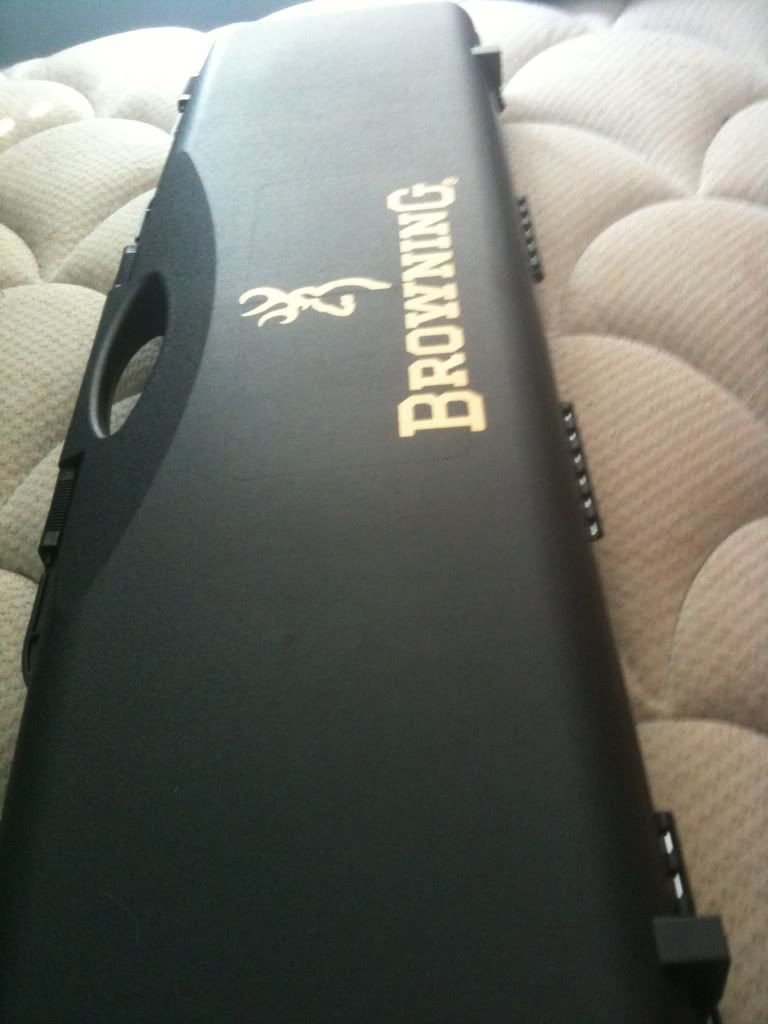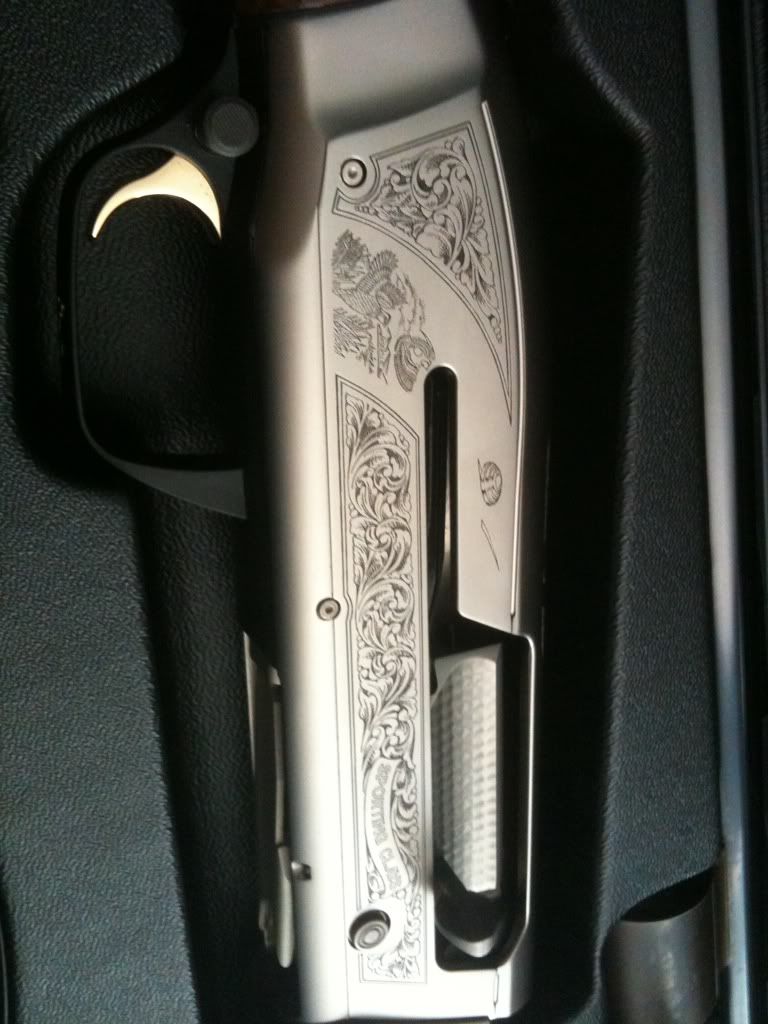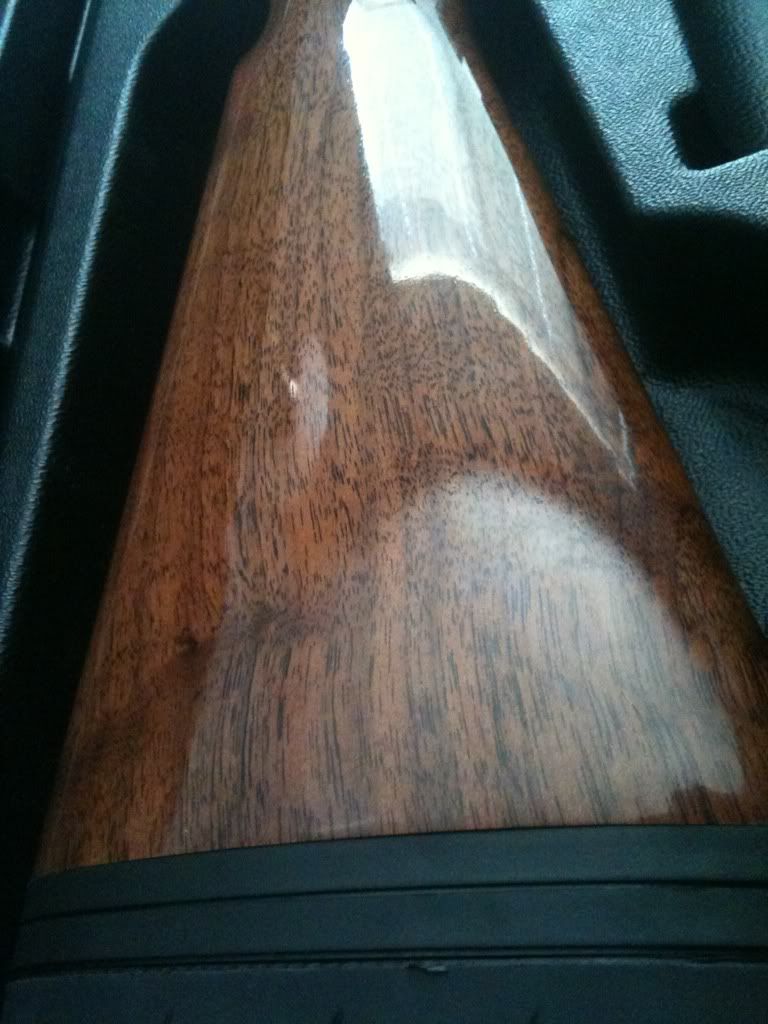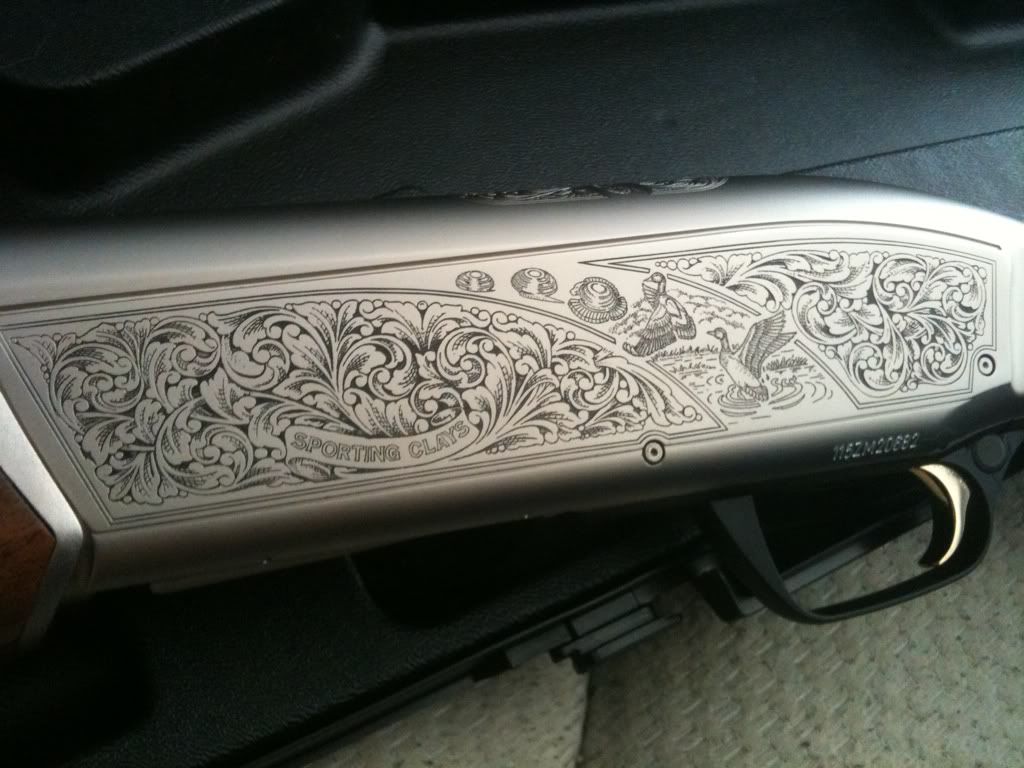Well, it finally arrived. It took over a month of waiting, but my Browning Maxus Sporting (12ga, 30") at long last made its way to the Bass Pro Shop in Ft. Myers, FL, where I adopted it and brought it home. Today I baptized it in gunpowder and lead shot on the skeet field, and I'm here to bring my thoughts on the matter to anyone who might be considering this new contender for addition to their own collection.
For those with ADD (or are in a particular hurry), here's the short version: it's an unbelievably excellent gun with palpable, tangible enhancements that make it worth every penny. Go buy one.
![Image]()
![Image]()
![Image]()
![Image]()
![Image]()
Now for a little more detailed breakdown.
IN THE BOX
The BMS comes packaged in a handsome textured black plastic case that secures with 4 sliding locks. On the outermost two slides, there are "lock holes" (for lack of a better term) which allow for locks to be applied, preventing access for travel or what have you. The gold Browning logo and name are emblazoned on the side. This is all relevant, because I'm told no other Maxus ships in this case besides the Sporting.
Inside, the case has foam egg crating lining the top and molded wells for all the gun's pieces and accessories. This is a breakdown case, so the barrel resides separate from the rest. The area where all the gun parts lie is made of a softer plastic, almost rubberized, to prevent scratches. It's a very nice setup, if not a little over-engineered, with cavities that hold nothing...perhaps for future accessories or alternate hardware setups.
Beside the gun and the case, here's what comes with the BMS:
APPEARANCE
There's no shortage of pictures of the BMS on the internet, so I won't get too in depth about it. I will say that 2D images don't do the engraving justice, though; the size of the BMS' receiver creates a significant canvas that is put to good use, and the satin nickle finish complements it elegantly. For some contrast, the side of the bolt is "jeweled" with a shiny concentric circle pattern. There's also a small golden Browning logo on the bottom of the trigger guard, which together with the gleaming gold trigger adds a bit of accent color.
As the honorable Randy Wakeman noted from his brief time with the BMS, the stock and forearm are real, honest-to-God walnut wood. Not veneers or laminates, but actual wood with character, warmth and depth. Up close, you can see tiny indentations within the grain and beneath the lacquer that are testament to that fact.
As with all Maxus models, the BMS lacks something most autoloaders have had for decades: a magazine cap. Instead, there's a Speed Lock forearm latch, identical in function to most O/U models. Push a button, pull a latch and you're done. As a result of this design, the end of the forearm is swept back at a 30 degree angle or so, lending a bit of aggression to the gun's look and aesthetically setting it aside from just about every other gun in its class.
For me, what was most visually appealing about the BMS as a total package was the way it blends the traditional (engraved receiver, real checkered wood) with the contemporary (satin nickle finish, no magazine cap) to create an evolution that still pays homage to the great traditions of the past. If there's anything negative to say about the gun's looks, it's that the barrel's glossy finish is an absolute fingerprint magnet...but that's such a niggling quarrel I'm almost embarrassed to mention it.
In the end, part of owning a "sporting" model of any gun is its visual appeal, and my BMS was snapping necks all day on the rack between rounds. Even though I had nothing to do with its design or development, I'd be lying if I said it didn't feel nice to have guys with $8K Caesar Guerinis gushing over my Maxus.
PERFORMANCE
So great, she's a looker, we get it. How does it shoot? On that end, I'm very pleased to report that the BMS is a dream. See, this is only my second shotgun; my first was a Remington 11-87 Sportsman Synthetic, more at home hunting turkeys in the woods than popping clay pigeons on a range. It weighed in at 8.5 pounds and though I enjoyed using it, there's just no comparison to the sleek, 7 pound 1 ounce BMS.
Though there are folks who espouse the use of heavy guns to smooth out swing and maintain momentum, the reduced weight of the BMS is one of the factors that made me consider it in the first place, especially for skeet. If the proper technique is defined as catching up to and then overtaking moving targets, wouldn't a lighter gun make that task easier? It's just simple physics.
And that's where the BMS shines. Its light weight, combined with its good balance, permitted me to pass targets faster and shoot them quicker than ever before. And as anyone who's ever missed those station 8 shots can attest, getting that barrel moving can make all the difference.
On the topic of recoil: Randy also pointed out in a recent article that recoil (particularly with 2 3/4" shells) these days is virtually a non-issue, a point I wholeheartedly agree with. Between high-tech recoil pads, light loads and gas operation, most modern autoloaders can be shot by even the smallest person with negligible issue. And so the BMS falls into this classification, since its kickback is supremely tolerable. The Influx pad that comes with it also does what the marketing suggests; namely, directs the recoil force downward, to combat muzzle flip. The result is easy acquisition of second targets; indeed, I only missed a single true pair in 5 rounds of skeet, success that I had never known before.
I saved the best for last, as my favorite performance feature has to be the Speed Load function. Most automatics must be breech-loaded on the first shell, with all other shells subsequently fed into the magazine tube after releasing the bolt. With the Maxus models' Speed Load, you just slide a shell into the magazine, and the gun immediately chambers it...making the BMS a literal autoloader. It may not sound like a big deal, but it feels like you're doing a magic trick! To not bother with the bolt release button for those single birds is just a nice little bonus that I enjoyed every single time I did it. You do have to make sure you get the shell all the way up in there, however, or the rim may hang up on the feeding ramp.
FINAL VERDICT
The BMS is over $1600 MSRP, but I paid $1399 from Bass, and after looking online, that was a pretty fair price considering the alternative retail options. And I think it was absolutely worth it, to get a high-grade gun that I can grow and compete with. Consider this: with my 11-87, the best score I ever put up at skeet was 20. My first three rounds with the BMS, a brand-new gun I had never shot before, were 22, 23 and 24! The proof really is in the shooting.
Head-turning looks, competition-grade performance and price potentially hundreds less than the comparatively dull 391 Teknys make the BMS worth a serious look if you're thinking about going over the $1K mark for an autoloader. If you fellas have any questions or comments, I'd love to hear them!
For those with ADD (or are in a particular hurry), here's the short version: it's an unbelievably excellent gun with palpable, tangible enhancements that make it worth every penny. Go buy one.





Now for a little more detailed breakdown.
IN THE BOX
The BMS comes packaged in a handsome textured black plastic case that secures with 4 sliding locks. On the outermost two slides, there are "lock holes" (for lack of a better term) which allow for locks to be applied, preventing access for travel or what have you. The gold Browning logo and name are emblazoned on the side. This is all relevant, because I'm told no other Maxus ships in this case besides the Sporting.
Inside, the case has foam egg crating lining the top and molded wells for all the gun's pieces and accessories. This is a breakdown case, so the barrel resides separate from the rest. The area where all the gun parts lie is made of a softer plastic, almost rubberized, to prevent scratches. It's a very nice setup, if not a little over-engineered, with cavities that hold nothing...perhaps for future accessories or alternate hardware setups.
Beside the gun and the case, here's what comes with the BMS:
- 9 HiViz sight inserts (small dot, big dot and triangle, all in white, green and orange)[/*]
- 1 extra 1/4" stock spacer (1 comes pre-installed for a total of 2)[/*]
- 6 cast/drop adjustment shims (neutral comes pre-installed)[/*]
- 5 Invector Plus flush chokes (SK, IC, MOD, IM, full comes pre-installed)[/*]
- 4 plastic choke tube vials[/*]
- Simple choke wrench[/*]
- Trigger lock (plastic, non-keyed, rudimentary and best thrown away)[/*]
- Various and sundry paperwork and manual[/*]
APPEARANCE
There's no shortage of pictures of the BMS on the internet, so I won't get too in depth about it. I will say that 2D images don't do the engraving justice, though; the size of the BMS' receiver creates a significant canvas that is put to good use, and the satin nickle finish complements it elegantly. For some contrast, the side of the bolt is "jeweled" with a shiny concentric circle pattern. There's also a small golden Browning logo on the bottom of the trigger guard, which together with the gleaming gold trigger adds a bit of accent color.
As the honorable Randy Wakeman noted from his brief time with the BMS, the stock and forearm are real, honest-to-God walnut wood. Not veneers or laminates, but actual wood with character, warmth and depth. Up close, you can see tiny indentations within the grain and beneath the lacquer that are testament to that fact.
As with all Maxus models, the BMS lacks something most autoloaders have had for decades: a magazine cap. Instead, there's a Speed Lock forearm latch, identical in function to most O/U models. Push a button, pull a latch and you're done. As a result of this design, the end of the forearm is swept back at a 30 degree angle or so, lending a bit of aggression to the gun's look and aesthetically setting it aside from just about every other gun in its class.
For me, what was most visually appealing about the BMS as a total package was the way it blends the traditional (engraved receiver, real checkered wood) with the contemporary (satin nickle finish, no magazine cap) to create an evolution that still pays homage to the great traditions of the past. If there's anything negative to say about the gun's looks, it's that the barrel's glossy finish is an absolute fingerprint magnet...but that's such a niggling quarrel I'm almost embarrassed to mention it.
In the end, part of owning a "sporting" model of any gun is its visual appeal, and my BMS was snapping necks all day on the rack between rounds. Even though I had nothing to do with its design or development, I'd be lying if I said it didn't feel nice to have guys with $8K Caesar Guerinis gushing over my Maxus.
PERFORMANCE
So great, she's a looker, we get it. How does it shoot? On that end, I'm very pleased to report that the BMS is a dream. See, this is only my second shotgun; my first was a Remington 11-87 Sportsman Synthetic, more at home hunting turkeys in the woods than popping clay pigeons on a range. It weighed in at 8.5 pounds and though I enjoyed using it, there's just no comparison to the sleek, 7 pound 1 ounce BMS.
Though there are folks who espouse the use of heavy guns to smooth out swing and maintain momentum, the reduced weight of the BMS is one of the factors that made me consider it in the first place, especially for skeet. If the proper technique is defined as catching up to and then overtaking moving targets, wouldn't a lighter gun make that task easier? It's just simple physics.
And that's where the BMS shines. Its light weight, combined with its good balance, permitted me to pass targets faster and shoot them quicker than ever before. And as anyone who's ever missed those station 8 shots can attest, getting that barrel moving can make all the difference.
On the topic of recoil: Randy also pointed out in a recent article that recoil (particularly with 2 3/4" shells) these days is virtually a non-issue, a point I wholeheartedly agree with. Between high-tech recoil pads, light loads and gas operation, most modern autoloaders can be shot by even the smallest person with negligible issue. And so the BMS falls into this classification, since its kickback is supremely tolerable. The Influx pad that comes with it also does what the marketing suggests; namely, directs the recoil force downward, to combat muzzle flip. The result is easy acquisition of second targets; indeed, I only missed a single true pair in 5 rounds of skeet, success that I had never known before.
I saved the best for last, as my favorite performance feature has to be the Speed Load function. Most automatics must be breech-loaded on the first shell, with all other shells subsequently fed into the magazine tube after releasing the bolt. With the Maxus models' Speed Load, you just slide a shell into the magazine, and the gun immediately chambers it...making the BMS a literal autoloader. It may not sound like a big deal, but it feels like you're doing a magic trick! To not bother with the bolt release button for those single birds is just a nice little bonus that I enjoyed every single time I did it. You do have to make sure you get the shell all the way up in there, however, or the rim may hang up on the feeding ramp.
FINAL VERDICT
The BMS is over $1600 MSRP, but I paid $1399 from Bass, and after looking online, that was a pretty fair price considering the alternative retail options. And I think it was absolutely worth it, to get a high-grade gun that I can grow and compete with. Consider this: with my 11-87, the best score I ever put up at skeet was 20. My first three rounds with the BMS, a brand-new gun I had never shot before, were 22, 23 and 24! The proof really is in the shooting.
Head-turning looks, competition-grade performance and price potentially hundreds less than the comparatively dull 391 Teknys make the BMS worth a serious look if you're thinking about going over the $1K mark for an autoloader. If you fellas have any questions or comments, I'd love to hear them!





